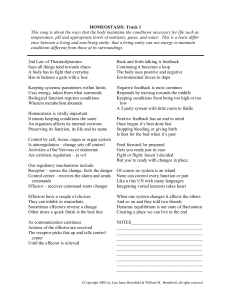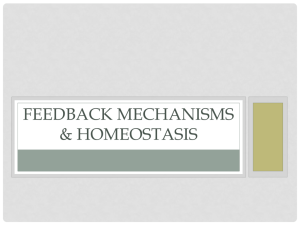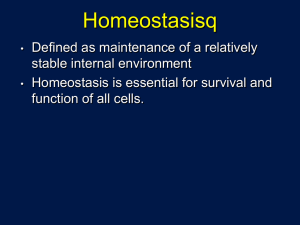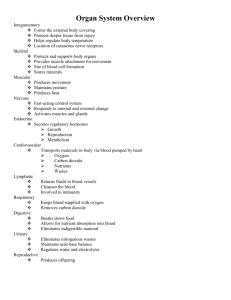Introduction to Anatomy
advertisement
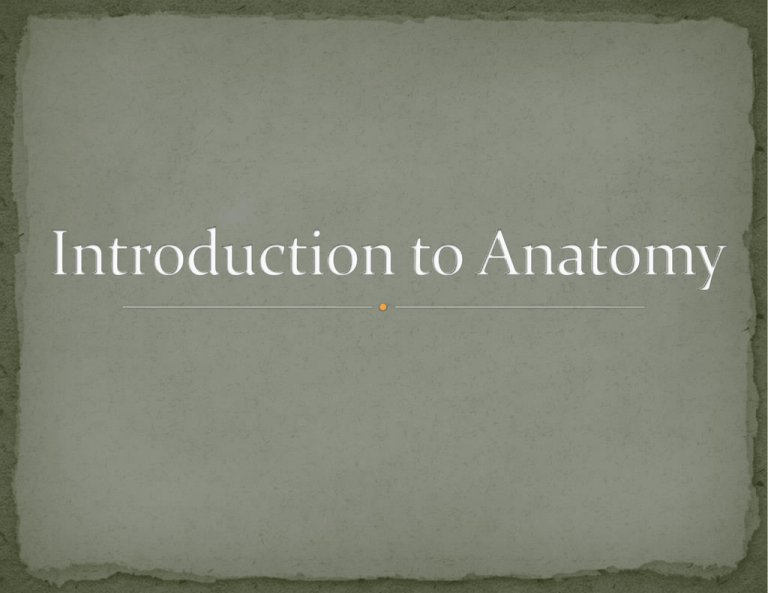
Anatomy Study of the structure and shape of the body and its parts Physiology Study of how the body and its parts work or function Gross anatomy Large structures Easily observable Figure 14.1 Microscopic Anatomy Very small structures Can only be viewed with a microscope Figure 14.4c–d Atoms Molecules Macromolecules Organelles Cells Tissues Organs Organ Systems Organism Integumentary Cardiovascular Skeletal Lymphatic Muscular Digestive Nervous Respiratory Endocrine Urinary Reproductive (male & female) Integumentary Forms the external body covering Protects deeper tissue from injury Helps regulate body temperature Location of cutaneous nerve receptors Figure 1.2a Skeletal Protects and supports body organs Provides muscle attachment for movement Site of blood cell formation Stores minerals Figure 1.2b Muscular Produces movement Maintains posture Produces heat Figure 1.2c Nervous Fast-acting control system Responds to internal and external change Activates muscles and glands Figure 1.2d Endocrine Secretes regulatory hormones Growth Reproduction Metabolism Figure 1.2e Cardiovascular Transports materials in body via blood pumped by heart Oxygen Carbon dioxide Nutrients Wastes Figure 1.2f Lymphatic Returns fluids to blood vessels Cleanses the blood Involved in immunity Figure 1.2g Respiratory Keeps blood supplied with oxygen Removes carbon dioxide Figure 1.2h Digestive Breaks down food Allows for nutrient absorption into blood Eliminates indigestible material Figure 1.2i Urinary Eliminates nitrogenous wastes Maintains acid-base balance Regulates water and electrolytes Figure 1.2j Reproductive Produces offspring Figure 1.2k–l Maintain boundaries Movement Locomotion Movement of substances Responsiveness Ability to sense changes and react Break-down and absorption of nutrients Metabolism—chemical reactions within the body Produces energy Makes body structures Excretion Eliminates waste from metabolic reactions Reproduction Produces future generation Growth Increases cell size and number of cells Nutrients Chemicals for energy and cell building Includes carbohydrates, proteins, lipids, vitamins, and minerals Oxygen Required for chemical reactions Water 60–80% of body weight Provides for metabolic reaction Stable body temperature Atmospheric pressure Must be appropriate Figure 1.3 Homeostasis—maintenance of a stable internal environment A dynamic state of equilibrium Homeostasis is necessary for normal body functioning and to sustain life Homeostatic imbalance A disturbance in homeostasis resulting in disease Input: Information sent along afferent pathway to Control center Output: Information sent along efferent pathway to activate Effector Receptor (sensor) Change detected by receptor Stimulus: Produces change Variable in variable (in homeostasis) Response of effector feeds back to influence magnitude of stimulus and returns variable to homeostasis Figure 1.4 Variable (in homeostasis) Figure 1.4, step 1a Stimulus: Produces change Variable in variable (in homeostasis) Figure 1.4, step 1b Receptor (sensor) Change detected by receptor Stimulus: Produces change Variable in variable (in homeostasis) Figure 1.4, step 2 Input: Information sent along afferent pathway to Control center Receptor (sensor) Change detected by receptor Stimulus: Produces change Variable in variable (in homeostasis) Figure 1.4, step 3 Input: Information sent along afferent pathway to Control center Output: Information sent along efferent pathway to activate Effector Receptor (sensor) Change detected by receptor Stimulus: Produces change Variable in variable (in homeostasis) Figure 1.4, step 4 Input: Information sent along afferent pathway to Control center Output: Information sent along efferent pathway to activate Effector Receptor (sensor) Change detected by receptor Stimulus: Produces change Variable in variable (in homeostasis) Response of effector feeds back to influence magnitude of stimulus and returns variable to homeostasis Figure 1.4, step 5 The body communicates through neural and hormonal control systems Receptor Responds to changes in the environment (stimuli) Sends information to control center Control center Determines set point Analyzes information Determines appropriate response Effector Provides a means for response to the stimulus a muscle contracting to move the arm a muscle squeezing saliva from the salivary gland a gland releasing a hormone into the blood The purpose of organ systems is to provide an organism with a stable internal environment. Injury and illness disrupt this internal balance. The body remains in homeostasis by a system called negative feedback. The negative feedback loop is the MOST common. Human and Animal medicine attempts to regain homeostasis within particular systems which cannot regain balance due to illness and injury. A positive feedback mechanism is the exact opposite of a negative feedback mechanism. With negative feedback, the output reduces the original effect of the stimulus. In a positive feedback system, the output enhances the original stimulus Examples: Child birth (production of Oxytocin to cause contractions) and blood clotting Just remember that positive feedback mechanisms enhance the original stimulus and negative feedback mechanisms inhibit it. Special terminology is used to prevent misunderstanding Exact terms are used for Position Direction Regions Structures Anatomical Position – a standard body position for studying the body—standing erect with arms at your side and palms facing ventral Table 1.1 (1 of 3) Table 1.1 (2 of 3) Table 1.1 (3 of 3) Superior Proximal Inferior Distal Ventral Superficial Dorsal Deep Medial Lateral A median (sagittal) section divides the body (or organ) into equal left and right parts A frontal (coronal) section divides the body (or organ) into anterior and posterior parts A transverse (cross) section divides the body (or organ) into superior and inferior parts Dorsal body cavity Cranial cavity houses the brain Spinal cavity houses the spinal cord Ventral body cavity Thoracic cavity houses heart, lungs and others Abdominopelvic cavity houses digestive system and most urinary system organs (pleural cavity) Figure 1.8c Serous membranes line the walls of cavities and cover organs. These membranes secrete serous fluid which lubricate the free surfaces.
